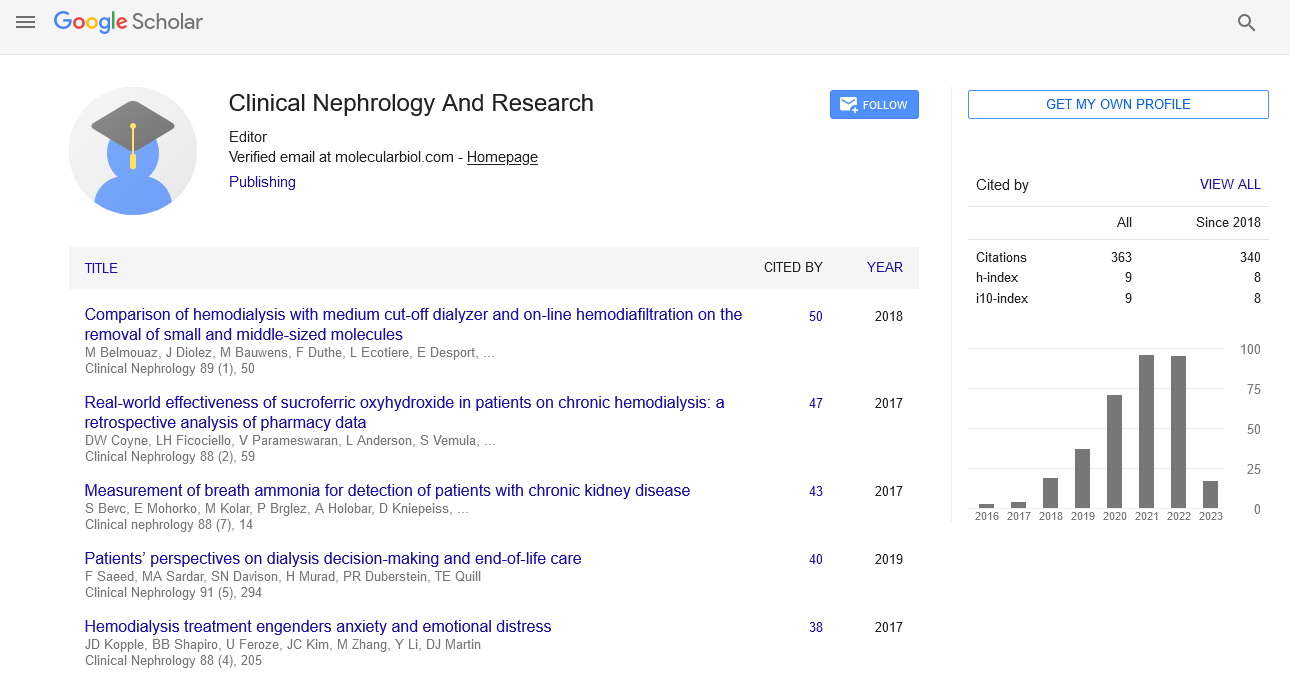Diabetic kidney disease
2 St Georges’, University of London, London, UK, Email: mark.dockrell@nhs.net
Received: 29-Aug-2017 Accepted Date: Aug 30, 2017; Published: 04-Sep-2017
Citation: Dockrell MEC. Diabetic kidney disease. Clin Nephrol Res. 2017;1(1):3.
This open-access article is distributed under the terms of the Creative Commons Attribution Non-Commercial License (CC BY-NC) (http://creativecommons.org/licenses/by-nc/4.0/), which permits reuse, distribution and reproduction of the article, provided that the original work is properly cited and the reuse is restricted to noncommercial purposes. For commercial reuse, contact reprints@pulsus.com
Screening for various medical conditions is believed to be cost effective when it is targeted at vulnerable or susceptible groups. This proposition, it could be argued, is no more appropriate than screening for chronic kidney disease in people with existing diabetes. The prevalence of CKD in the UK general population is probably around 6%; in patients with diabetes it’s closer to 30%.
Of course, to some extent screening of patients with diabetes for renal damage already happens. The only two commonly used and widely accepted biomarkers in diabetic CKD are serum creatinine and urinary albumin. Part of the annual diabetic health check should include a “microalbuminuria test”. The received wisdom is that the natural history of diabetic kidney disease begins with microalbuminuria followed by a decrease in eGFR, determined from serum creatinine levels, and eventually renal failure. The source of the albumin in the urine has been debated but the weight of evidence suggests that it is probably due to a failure of receptor-mediated endocytosis by the proximal tubule cells. This was corroborated to some degree when the Brunskill group from Leicester in the UK identified that a transient albuminuria induced by statins was due to inhibition of the Rho GTPases in the proximal tubule preventing receptor mediated endocytosis.
However, more recently the phenomenon of non-albuminuric diabetic kidney disease has been increasingly recognised. If the disease develops in the absence of the biomarker, even in a minority of cases, it is a clear indication that this particular marker is not an integral part of the disease process if indeed it is one disease.
These results have stimulated the hunt for other, better, markers of progressive diabetic kidney damage, and there is no shortage of candidates; many markers of proximal tubular damage. Urinary N-acetyl-β D glucosaminidase (NAG) has been reported in a number of different studies as a maker of early diabetic nephropathy and NAG is indeed a sensitive marker of proximal tubule damage. NAG is a high molecular weight (140 kDa) lysosomal enzyme. It shows high activity in renal proximal tubule cells. Following tubular injury, NAG leaks into the tubular fluid and is detected in the urine. However, its presence in urine is not restricted to diabetes and as a marker of acute injury its urinary concentration will drop if the injury subsides or enters remission. As a marker of diabetic kidney damage it is probably more useful when considered in the context of markers of other features of renal function. There are other markers of acute kidney injury that have migrated over to diabetic nephropathy such as NGAL and Kim-1.Urinary NGAL, Neutrophil gelatinase-associated lipocalin, can have many sources. At 25 KDa it is freely filtered by the glomerulus and largely reabsorbed by megalin mediated endocytosis; consequently an increase in urinary NGAL could result from over flow from the circulation or a failure in proximal tubule mediated endocytosis adding to that secreted from the tubule. Kidney injury molecule-1/T cell IgG and mucin containing 1 (KIM-1/ TIM-1) is a membrane protein upregulated in proximal tubular cells following injury and function as an apoptotic cell phagocytosis and scavenger receptor.
With the proximal tubule clearly in the sights it is worth considering what features of diabetes may actually be relevant to cellular and subsequent organ damage to help suggest novel makers
HbA1c is a known correlate of progressive diabetic kidney disease indicating an increase in glycated proteins. These proteins can act directly on proximal tubule cells to increase mediators of fibrosis such as connective tissue growth factor (CTGF/CCN2) and Transforming Growth Factor β1 (TGF β1). The level of urinary TGF β1, a powerful regulator of fibrosis and mediator of tubule cell damage, is also acutely raised by an increase in blood glucose. Both TGF β1 and CTGF/CCN2 act on proximal tubules to induce a number of changes including disruption of cadherin expression. Cadherin proteins are critical in maintaining epithelial integrity and cellular phenotype. In the human kidney the proximal tubule is the sole source of K-cadherin (cadherin 6).
The loss of K-Cadherin is a cell type specific marker from a cell type believed to be key in the process of diabetic kidney disease and the subsequent tubulointerstitial fibrosis. It is a response to a specific type of insult. It does not suggest a structural change, it is a structural change. It is not a marker of loss of function, it is a cause of loss function and loss of phenotype. But can it be easily measured and does the measurement inform us about a propensity to loss of renal function or progression of diabetic kidney disease?
It is early days; evidence of K-cadherin as a marker of renal cell carcinoma has been around for over 20 years but studies of its utility in diabetic kidney disease are only starting to appear. That said, the preliminary evidence is positive, and the answers to the questions above appear to be yes. The presence of full length k-cadherin – importantly not fragments – can be measured by a research ELISA. In a study of 300 diabetic patients urinary K-cadherin levels were associated with progressive loss of function. In patients with diabetes; whether the patients had an eGFR <60 or perhaps more importantly >60 the concentration of urinary full length K-cadherin was approximately double in “progressors” compared to “non progressors”.





